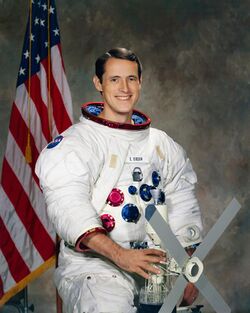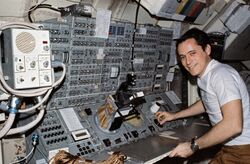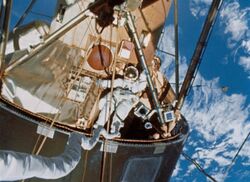Edward Gibson
Topic: Biography
 From HandWiki - Reading time: 6 min
From HandWiki - Reading time: 6 min
Edward G. Gibson | |
|---|---|
 | |
| Born | November 8, 1936 Buffalo, New York, U.S. |
| Status | Retired |
| Nationality | American |
| Other names | Edward George Gibson |
| Alma mater | University of Rochester, B.S. 1959 California Institute of Technology, M.S. 1960, Ph.D. 1964 |
| Occupation |
|
| Awards | |
| Space career | |
| NASA Astronaut | |
Time in space | 84d 01h 15m |
| Selection | 1965 NASA Group 4 |
Total EVAs | 3 |
Total EVA time | 15 hours 22 minutes |
| Missions | Skylab 4 |
Mission insignia | |
| Retirement | October 31, 1982 |
Edward George Gibson (born November 8, 1936) is a former NASA astronaut, pilot, engineer, and physicist.
Before becoming a NASA astronaut, Gibson graduated from the University of Rochester and the California Institute of Technology. He became a research assistant in jet propulsion while completing his studies and eventually became a research scientist for Philco Corporation until joining NASA.
Gibson was selected as an astronaut by NASA in 1965 as part of Astronaut Group 4, the first group of scientist-astronauts. He served on the support crew of Apollo 12 before moving on to work on the development of the Skylab space station. In 1973–74, Gibson made his first and only flight into space as science pilot aboard Skylab 4, the third and final manned flight to Skylab. He, along with Commander Gerald Carr and Pilot William Pogue, spent just over 84 days in space. Gibson resigned from NASA in December 1974, but returned in 1977 to preside over the selection of scientist-astronaut candidates. Gibson retired from NASA for the last time in October 1982.[1]
Biography
Early life and education
Gibson was born in Buffalo, New York, on November 8, 1936. From ages 2 to 8, Gibson battled osteomyelitis—soft spots in bones—and spent many months in and out of hospitals. Newly-available penicillin cured the disease. To strengthen his leg that was nearly amputated, Gibson took up sports: swimming, football, and track.[2]
He graduated from Kenmore Senior High School in Kenmore, New York and earned a Bachelor of Science degree in engineering from the University of Rochester in June 1959. At the University of Rochester, Gibson became a member of the Theta Chi fraternity. He received a Master of Science degree in engineering (jet propulsion option) from the California Institute of Technology (Caltech) in June 1960 and a Ph.D. in engineering with a minor in physics from Caltech in June 1964. Gibson has also been presented with honorary doctorates of science from the University of Rochester and Wagner College in New York City , both in 1974.[3]
He was active in the Boy Scouts of America. He earned the rank of First Class.[4]
Early career
While studying at Caltech, Gibson was a research assistant in the field of jet propulsion and classical physics. His technical publications are in the fields of plasma physics and solar physics. He was senior research scientist with the Applied Research Laboratories of the Philco Corporation at Newport Beach, California, from June 1964 until moving to NASA. While at Philco, he did research in lasers and the optical breakdown of gases.[3]
Gibson has logged more than 4,300 hours flying time—2,270 hours in jet aircraft.[3]
NASA career
Gibson was selected as a scientist-astronaut by NASA in June 1965. He completed a 53-week course in flight training at Williams Air Force Base, Arizona, and earned his Air Force wings. Since then, he has flown helicopters and the T-38.[3]
He served as a member of the astronaut support crew and as a CAPCOM for the Apollo 12 lunar landing, becoming the first from the scientist-astronaut group to get a crew assignment of any kind. He also participated in the design and testing of many elements of the Skylab space station.[3] As part of his preparation for the Skylab program, Gibson studied solar physics, ultimately writing an introductory monograph/textbook on solar astrophysics The Quiet Sun, apart from 1973 English edition published in the United States there was 1977 Russian edition of this book, published in the Soviet Union by Mir Publishers.
Skylab 4

Gibson was the Science Pilot of Skylab 4 (third and final manned visit to the Skylab space station), launched November 16, 1973, and concluded February 8, 1974. This was the longest manned flight (84 days 1 hour 15 minutes) in the history of manned space exploration at that time. Gibson was accompanied on the record-setting 34.5-million-mile flight by Gerald P. Carr (Commander) and William R. Pogue (Pilot). They successfully completed 56 experiments, 26 science demonstrations, 15 subsystem detailed objectives, and 13 student investigations during their 1,214 revolutions of the Earth. They also acquired a wide variety of earth resources observations data using Skylab’s earth resources experiment package camera and sensor array. Dr. Gibson was the crewman primarily responsible for the 338 hours of Apollo Telescope Mount operation, which made extensive observations of solar processes.[5]
Until March 1978, Gibson and his Skylab-4 teammates held the world record for individual time in space: 2,017 hours 15 minutes 32 seconds, and Gibson logged 15 hours and 22 minutes in three EVAs outside the Skylab Orbital Workshop.
Gibson resigned from NASA in December 1974 to do research on Skylab solar physics data as a senior staff scientist with the Aerospace Corporation of Los Angeles, California. Beginning in March 1976, he served for one year as a consultant to ERNO Raumfahrttechnik GmbH, in West Germany, on Spacelab design under the sponsorship of a U.S. Senior Scientist Award form the Alexander von Humboldt Foundation. In March 1977, Gibson returned to the Astronaut Office astronaut candidate selection and training as Chief of the Scientist-Astronaut Candidates. During his second tenure at NASA, Gibson had hoped to fly on another space station mission due to his experience on Skylab, but at the same time was not keen on flying a Space Shuttle mission. Gibson ultimately decided to retire from NASA again on October 31, 1982 and began working for TRW.[6]
Post-NASA and later work
In October 1990, Gibson began his own consulting firm, Gibson International Corp. The firm provides consulting services on program management, market development and space infrastructure design and operations.[3]
After his NASA career, Gibson held marketing and program management positions with Booz Allen Hamilton and TRW in the areas of space and energy development. He was the President of the Oregon Museum of Science and Industry and his own consulting company, Gibson International. Currently he is Senior vice president, Science Applications International Corporation, and manager of its EROS Data Center Operation in Sioux Falls, South Dakota.
He has performed a significant amount of speaking and writing, having published a text book in solar physics, two novels (Reach[7] and In the Wrong Hands[8]), and edited The Greatest Adventure, a compilation of stories and pictures on space missions from many astronauts and cosmonauts around the world.
Organizations
Gibson was elected a fellow of the American Astronautical Society. He is a member of the American Institute of Aeronautics and Astronautics (AIAA) and a member of Tau Beta Pi, an engineering honorary organization. Gibson much later became a member of the Seniors Track Club.[3]
Special honors
Gibson was awarded a National Science Foundation Fellowship and the R.C. Baker Fellowship at the California Institute of Technology, and he is listed in several Who's Who publications.[citation needed] He received the Johnson Space Center Certificate of Commendation (1970), the NASA Distinguished Service Medal (presented by President Richard M. Nixon in 1974) and the NASA Space Flight Medal, the City of New York City Gold Medal (1974), the Robert J. Collier Trophy for (1974), the Dr. Robert H. Goddard Memorial Trophy for 1975 (1975), the Fédération Aéronautique Internationale awarded him the De la Vaulx Medal and the V. M. Komarov Diploma for 1974 (1975), the American Astronautical Society’s 1975 Flight Achievement Award (1976), the AIAA Haley Astronautics Award for 1975 (1976), a Senior U.S. Scientist Award from the Alexander von Humboldt Foundation (1976), and a JSC Special Achievement Award (1978). He was inducted into the U.S. Astronaut Hall of Fame in 1997.[9]
Personal
Gibson is married to Julie Anne Volk of Tonawanda, New York. He has four children: Jannet Lynn (born November 9, 1960), John Edward (born May 2, 1964), Julie Ann (born October 12, 1968), and Joseph Michael (born July 11, 1971).[10]
Media appearances
In the 1998 HBO miniseries From the Earth to the Moon (1998), Gibson was played by actor Geoffrey Nauffts.[11]
See also
- Booz Allen Hamilton
- List of spaceflight records
- Skylab mutiny
References
- ↑ Burgess, Colin; David J. Shayler (2006). NASA's Scientist-Astronauts. pp. 336.
- ↑ Recer, Paul (1973-11-23). "Skylab 3 Astronauts are Welded Together by a Single Thread" (in en). Newspapers.com. Associated Press (Greely Daily Tribune (Greely, CO)). https://www.newspapers.com/clip/22158625/skylab_3_astronauts_are_welded_together/.
- ↑ 3.0 3.1 3.2 3.3 3.4 3.5 3.6 "Edward Gibson NASA Biography". NASA. https://www.jsc.nasa.gov/Bios/htmlbios/gibson-eg.html.
- ↑ Edward G. Gibson at scouting.org
- ↑ "NASA's Scientist-Astronauts," David Shayler and Colin Burgess
- ↑ Burgess, Colin; David J. Shayler (2006). NASA's Scientist-Astronauts. pp. 336.
- ↑ Gibson, Edward G. (1989). Reach: a novel. New York: Doubleday. ISBN 978-0-385-26150-0. OCLC 19127626. https://books.google.com/books?id=BiGbAAAACAAJ&dq=isbn:9780385261500.
- ↑ Gibson, Edward G. (1992). In the wrong hands. New York: Bantam. ISBN 978-0-553-29567-2. OCLC 25720911. https://books.google.com/books?id=ShSSA4zmh2kC&dq=isbn:9780553295672.
- ↑ Edward G. Gibson , retrieved 2007-08-23
- ↑ Edward Gibson's family
- ↑ "From the Earth to the Moon, Full Cast and Crew". IMDb. https://www.imdb.com/title/tt0120570/fullcredits?ref_=tt_cl_sm#cast.
External links
- Gibson's official NASA biography
- Motivational Speaker
- Astronautix biography of Edward Gibson
- Spacefacts biography of Edward Gibson
- Gibson at Spaceacts
- Gibson at Encyclopedia of Science
 KSF
KSF


